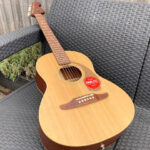For anyone starting their musical journey with the guitar, one of the first hurdles is understanding the instrument itself. Guitars, in their most common modern form, feature six strings. These aren’t just numbered; each Guitar String Name corresponds to a specific musical note, forming the foundation of how you play chords and melodies. The contemporary six-string guitar evolved from older stringed instruments, eventually settling on a design and tuning system that maximizes playability and musical versatility. By the mid-1800s, the six-string classical guitar, tuned to EADGBE, became widely established.
This standard tuning, EADGBE, wasn’t arbitrarily chosen. It represents a balance carefully refined over centuries. This tuning system is designed to make playing the guitar as intuitive and efficient as possible, considering several key factors:
The Balancing Act of Standard Tuning
Why EADGBE? It’s a question many beginners ask, and the answer lies in how well this tuning accommodates the fundamental aspects of guitar playing:
- Chord Formation: Standard tuning makes it relatively easy to form a wide variety of chords across the fretboard. The intervals between the strings are optimized to allow for common chord shapes that are comfortable for the hand.
- Melody Playing: While facilitating chords, EADGBE tuning also allows for fluid melodic lines. The string spacing and tuning intervals prevent excessive stretching of the fingers when playing scales and melodies.
- Open String Utilization: Standard tuning allows for the use of open strings in many keys and chords. Open strings resonate freely, adding richness to the sound and simplifying certain chord voicings.
- String Tension and Flexibility: The chosen intervals ensure a balanced tension across the neck. This balance allows for comfortable string bending, a crucial technique in many guitar styles, without putting undue stress on the guitar itself.
Imagine if a guitar was tuned with very large intervals between strings. Forming chords would become incredibly awkward and challenging. Conversely, tuning with very small intervals might make melodies easier in some ways, but common chord shapes would become complex and unwieldy. EADGBE strikes that crucial balance.
Decoding the Guitar String Names: From Thick to Thin
To understand guitar string names, it’s essential to know the numbering system. The strings are numbered from thickest to thinnest. The thickest string is the 6th string, and the thinnest is the 1st string.
In standard EADGBE tuning:
- 6th String: This is the thickest string and is tuned to E. It’s often referred to as the “Low E string” because it produces the lowest pitch on the guitar in standard tuning.
- 5th String: The next string up is the A string, tuned to the note A.
- 4th String: This is the D string, tuned to the note D.
- 3rd String: The G string, tuned to the note G.
- 2nd String: The B string, tuned to the note B.
- 1st String: The thinnest string, tuned to E. This is often called the “High E string” as it’s the highest pitched string in standard tuning.
Mnemonic Devices: Your Secret Weapon to Remembering String Names
Memorizing the guitar string names in order is a fundamental step. Luckily, there’s a helpful trick: using mnemonic phrases. These phrases create memorable associations, making it easier to recall the string order.
Starting from the thinnest string (1st string – High E) upwards to the thickest (6th string – Low E), the order is E-B-G-D-A-E. Here are some examples to get you started:
- Every Boy Gets Dessert After Eating
- Elephants Bounce Gracefully Down All Elevators
- Eat Big Green Donuts And Exit
Alternatively, starting from the thickest string (6th string – Low E) down to the thinnest (1st string – High E), the order is E-A-D-G-B-E. Here are phrases for this direction:
- Eddie Ate Dynamite, Good Bye Eddie
- Every Average Dude Gets Better Eventually
- Eat All Day, Get Big Easy
The best approach is to create your own mnemonic! The more personal and unusual the phrase, the easier it will be for you to remember.
Taking it Further: String Names and the Fretboard
Knowing the guitar string names is just the beginning. The fretboard, the wooden strip on the guitar neck, is where you bring these names to life. Pressing down on a string at different frets changes the vibrating length of the string, thus changing the pitch.
Understanding the names of the open strings is your first step to navigating the fretboard. As you learn more about guitar playing, you’ll discover how these string names relate to notes all across the fretboard, unlocking a world of musical possibilities.
Start with memorizing those string names and get ready to explore the exciting world of guitar playing!

